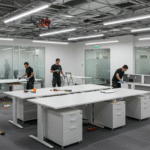Running a business involves many moving parts. One major area where costs can get out of control is facility management. If not handled properly, it can quietly drain your resources. But with a smart strategy, you can reduce operating expenses without sacrificing quality or comfort.
This blog will walk you through how effective facility management services can lead to big savings, and where to start if you’re looking to cut costs.
Tips to Reduce Operating Costs with Effective Facility Management
Conduct an Energy Audit
Start with energy usage. Many facilities waste energy without even knowing it. An energy audit helps you identify where energy is being lost and what can be done to fix it.
Common solutions include:
- Switching to LED lighting
- Installing motion sensors in low-traffic areas
- Sealing windows and doors
- Upgrading to energy-efficient HVAC systems
Even small fixes can add up to large savings over time.
Preventive Maintenance Saves Money
Reactive maintenance is costly. Waiting for things to break before fixing them usually leads to expensive repairs and downtime.
Preventive maintenance, on the other hand, helps catch problems early. For example:
- Regular HVAC checks keep systems running efficiently
- Elevator inspections reduce unexpected failures
- Roof maintenance prevents leaks and water damage
When you maintain your assets regularly, they last longer and perform better. This reduces repair costs and extends the lifespan of your equipment.
Optimize Space Usage
Unused or poorly used space costs money. Think about the rent, utilities, and cleaning for an area that no one really needs.
A facility manager can help analyze how your space is used and make recommendations. You might discover:
- Areas that can be downsized
- Spaces that can be repurposed for better use
- Ways to rearrange workstations to improve efficiency
Smarter space planning means fewer wasted resources.
Also Read: How to Minimize Downtime During a Corporate Relocation
Embrace Automation and Smart Technology
Modern facility management tools can save both time and money. Smart thermostats, lighting controls, and building management systems (BMS) can all help reduce unnecessary usage.
For example:
- Smart lighting adjusts based on natural light and occupancy
- BMS platforms monitor and control HVAC usage remotely
- Automated cleaning equipment reduces manual labor hours
The upfront investment in technology often pays for itself in reduced operating costs over time.
Outsource Where It Makes Sense
Not every task needs to be handled in-house. In many cases, outsourcing services like janitorial, landscaping, or security can reduce costs.
Outsourcing helps you:
- Avoid full-time salaries and benefits
- Work with experts in each field
- Scale services up or down as needed
It’s a great way to improve service quality while staying cost-effective.
Monitor Utility Bills Regularly
Utility bills can fluctuate from month to month. A sudden spike often signals a problem, like a water leak, equipment failure, or overuse of energy.
Set up a system to track and review utility bills regularly. Look for trends and compare usage over time. This allows you to:
- Spot inefficiencies early
- Identify areas where usage can be reduced
- Negotiate better rates with service providers
Staying on top of bills can lead to immediate cost savings.
Train Staff to Be More Cost-Conscious
Your facility team plays a major role in cost control. If they’re not trained to think about efficiency, opportunities may be missed.
Hold regular training sessions to cover:
- Energy-saving habits
- Waste reduction tips
- Proper use of equipment
Even small behavioral changes across your staff can have a big impact over time.
Standardize Procurement
Buying supplies and equipment from multiple vendors can increase costs. Standardizing purchasing across departments saves money through:
- Bulk discounts
- Lower delivery costs
- Easier inventory management
You may even want to negotiate contracts with preferred vendors to lock in better prices.
Set KPIs and Track Results
How do you know if your efforts are working? Set clear goals and measure them. Some common key performance indicators (KPIs) include:
- Energy cost per square foot
- Equipment uptime
- Maintenance costs
- Response times for service requests
Tracking KPIs helps you stay focused and adjust when necessary.
Hire or Appoint a Dedicated Facility Manager
If your business doesn’t already have one, consider hiring a facility manager. This person can oversee all aspects of your building and ensure everything runs smoothly and cost-effectively.
A good facility manager will:
- Monitor performance
- Keep maintenance schedules up to date
- Identify areas for improvement
- Work closely with vendors and contractors
It’s an investment that can pay off in long-term savings.
Contact Brothers Fix for Effective Facility Management
Reach out to Brothers Fix for effective facility management solutions that help you reduce costs, increase efficiency, and maintain seamless daily operations. Whether you require assistance with maintenance, repairs, or comprehensive facility oversight, our team provides reliable and professional support tailored to your specific business needs. We focus on proactive strategies that minimize downtime and maximize value. Trust Brothers Fix to keep your workspace running at its best—on time, on budget, and always with quality service you can count on.













